October 22, 2017, through January 21, 2018
NATIONAL GALLERY OF ART, Washington
 Johannes Vermeer: The Astronomer (detail)
Johannes Vermeer: The Astronomer (detail)
Dutch Golden Age painters from 1650 to 1675, when they reached
the height of their technical ability and mastery at depicting domestic life
Some 65 masterpieces by Johannes Vermeer and his contemporaries—including Gerard ter Borch, Gerrit Dou, Pieter de Hooch, Nicolas Maes, Eglon van der Neer, Caspar Netscher, and Jacob Ochtervelt—are grouped by theme, composition, and technique, thereby demonstrating how these painters admired, challenged, and pushed each other to greater artistic achievement.
The paintings also reflect how these masters responded to the changing artistic climate of the Dutch Republic in the third quarter of the 17th century, particularly in Amsterdam, Haarlem, Leiden, Deventer, Rotterdam, and Delft.
Highlights
JOHANNES VERMEER
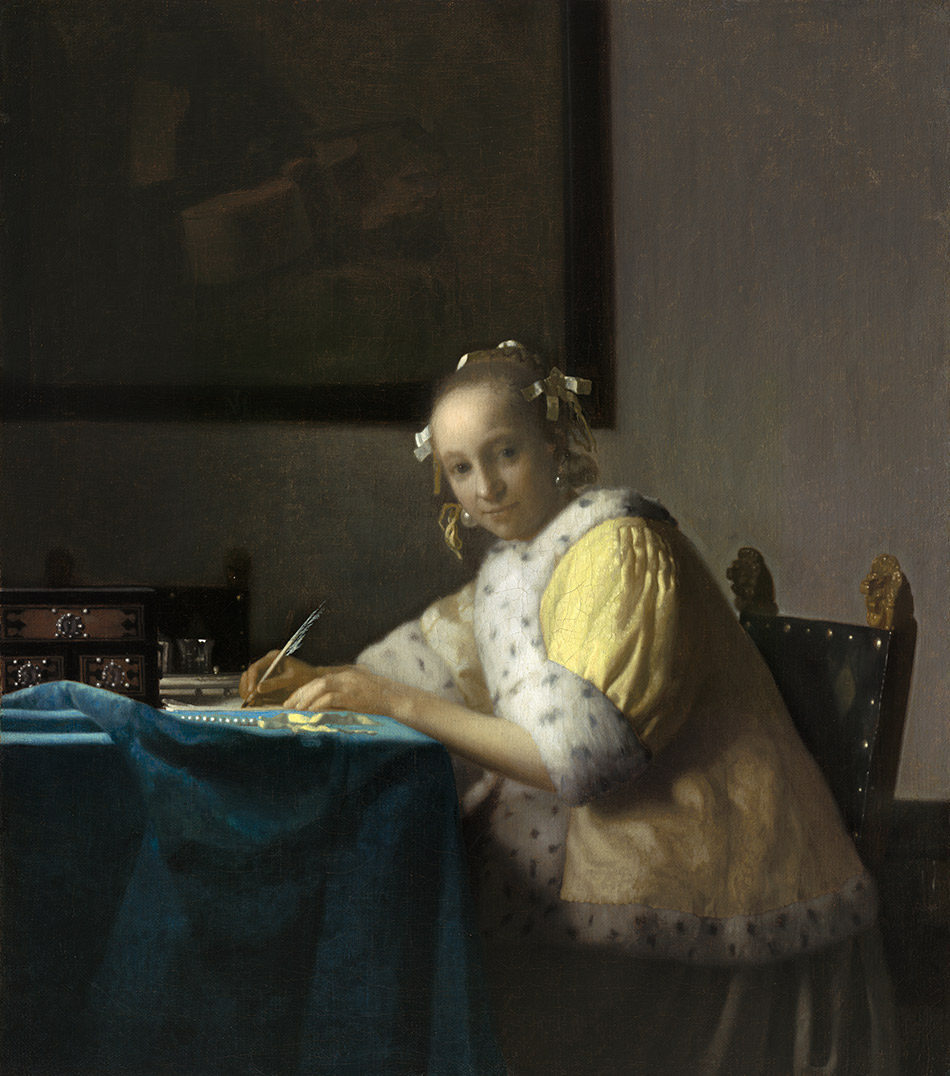
Johannes Vermeer, Lady Writing, c. 1665, oil on canvas, overall: 45 x 39.9 cm (17 11/16 x 15 11/16 in.) framed: 68.3 x 62.2 x 7 cm (26 7/8 x 24 1/2 x 2 3/4 in.) National Gallery of Art, Washington, Gift of Harry Waldron Havemeyer and Horace Havemeyer, Jr., in memory of their father, Horace Havemeyer

Johannes Vermeer, The Lacemaker, c. 1670-71, oil on canvas transferred to panel, Overall (painted surface): 23.9 x 20.5 cm (9 7/16 x 8 1/16 in.) overall (unframed): 24.5 x 21 cm (9 5/8 x 8 1/4 in.) overall (framed): 71 x 63 cm (27 15/16 x 24 13/16 in.) Musée du Louvre, Département des Peintures, Paris Photo © RMN-Grand Palais (Musée du Louvre)/Gérard Blot
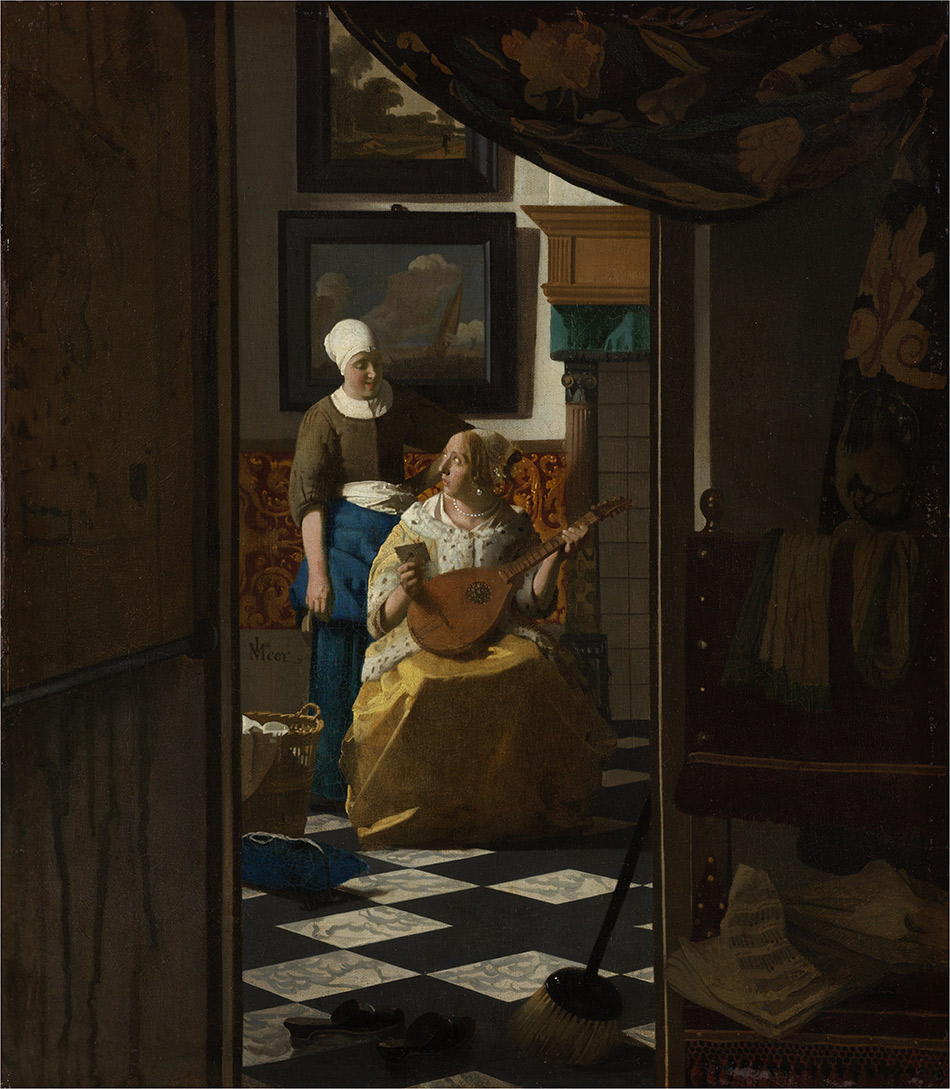
Johannes Vermeer, The Love Letter, c. 1669-70, oil on canvas, Overall (painted surface): 44 x 38 cm (17 5/16 x 14 15/16 in.) overall (unframed): 44 x 38.5 cm (17 5/16 x 15 3/16 in.) Rijksmuseum, purchased with the support of Vereniging Rembrandt
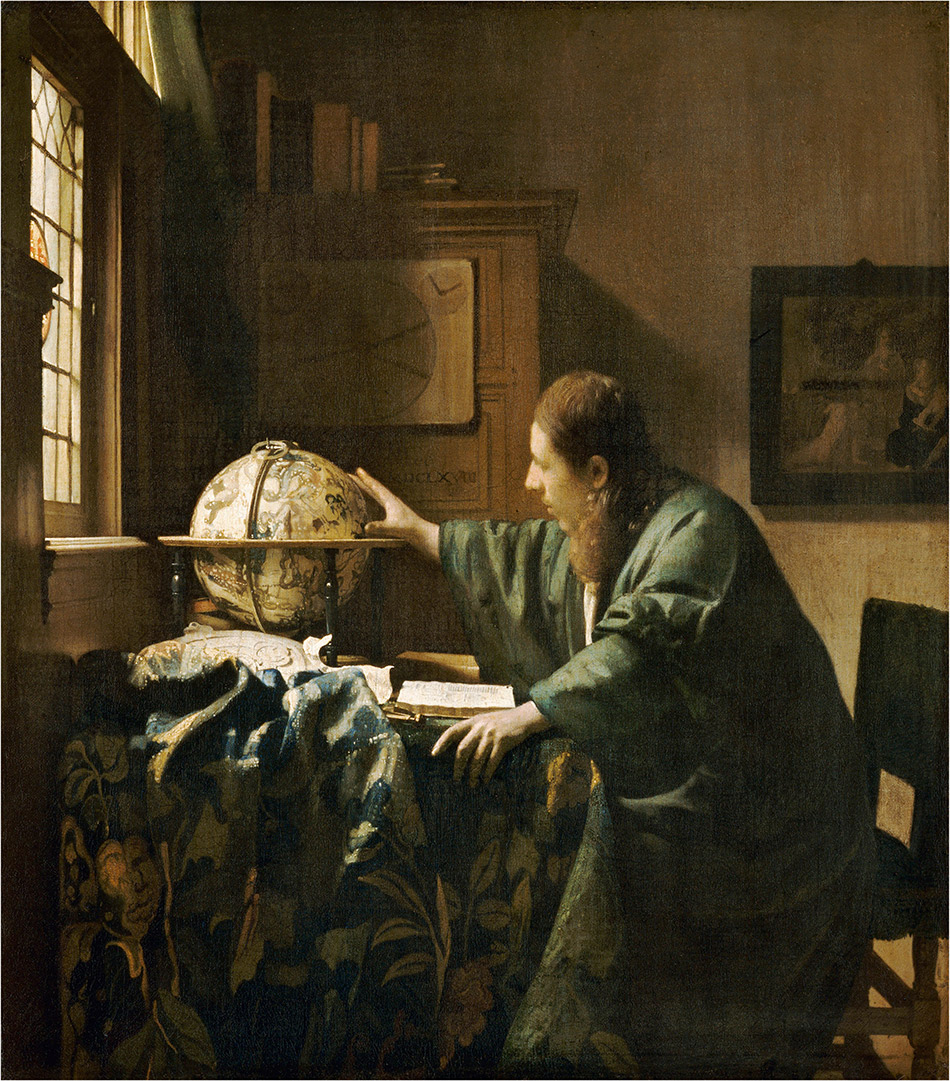
Johannes Vermeer, The Astronomer, 1668, oil on canvas, overall: 51.5 × 45.5 cm (20 1/4 × 17 15/16 in.) framed: 72.5 × 66.5 × 9 cm (28 9/16 × 26 3/16 × 3 9/16 in.) Musée du Louvre, Département des Peintures, Paris Photo © RMN-Grand Palais (Musée du Louvre)/Franck Raux

Johannes Vermeer, Woman Holding a Balance, c. 1664, oil on canvas, painted surface: 39.7 x 35.5 cm (15 5/8 x 14 in.) stretcher size: 42.5 x 38 cm (16 3/4 x 14 15/16 in.) framed: 62.9 x 58.4 x 7.6 cm (24 3/4 x 23 x 3 in.) National Gallery of Art, Washington, Widener Collection
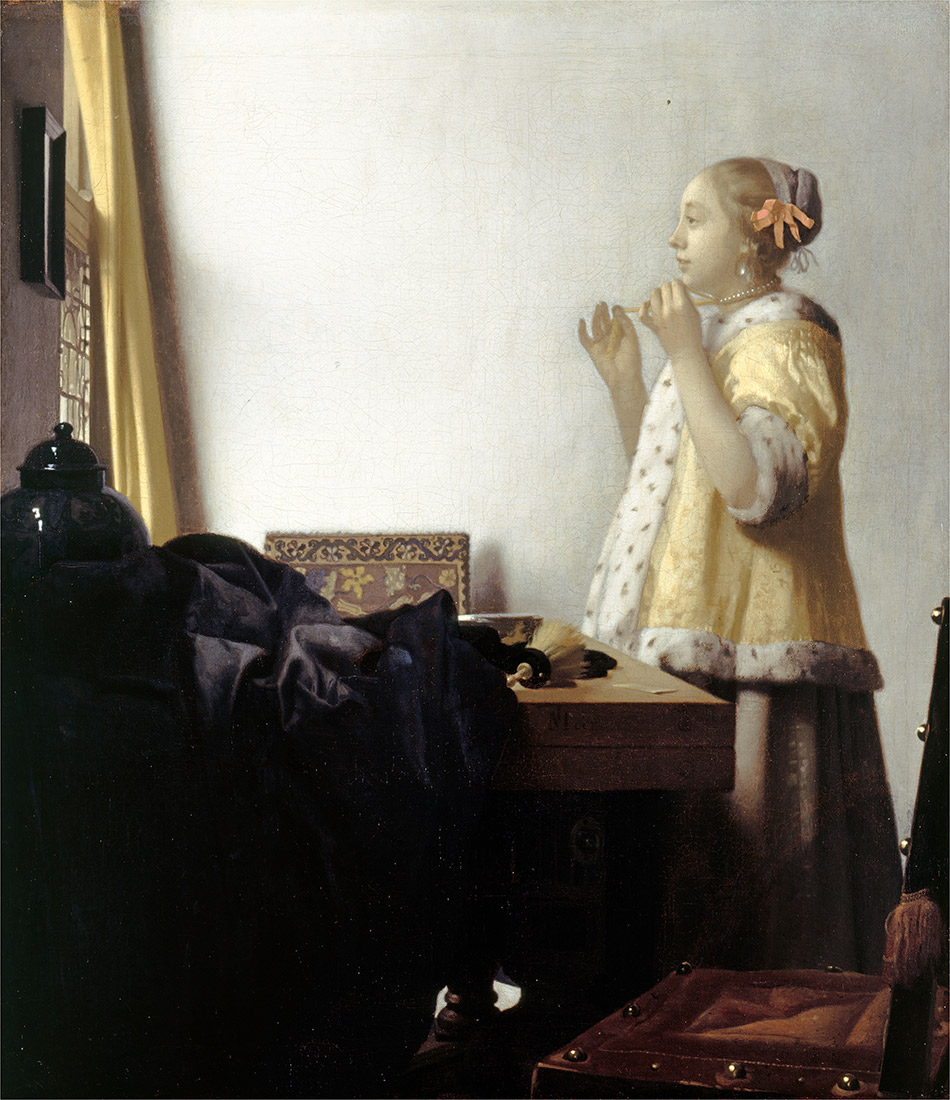 Johannes Vermeer, Woman with a Pearl Necklace, c. 1662-65, oil on canvas, Overall (painted surface): 51.2 x 45.1 cm (20 3/16 x 17 3/4 in.) overall (unframed): 55 x 45 cm (21 5/8 x 17 11/16 in.) overall (framed): 76 x 69 cm (29 15/16 x 27 3/16 in.) Staatliche Museen zu Berlin, Gemäldegalerie bpk/Gemäldegalerie, SMB/Jörg P. Anders
Johannes Vermeer, Woman with a Pearl Necklace, c. 1662-65, oil on canvas, Overall (painted surface): 51.2 x 45.1 cm (20 3/16 x 17 3/4 in.) overall (unframed): 55 x 45 cm (21 5/8 x 17 11/16 in.) overall (framed): 76 x 69 cm (29 15/16 x 27 3/16 in.) Staatliche Museen zu Berlin, Gemäldegalerie bpk/Gemäldegalerie, SMB/Jörg P. Anders
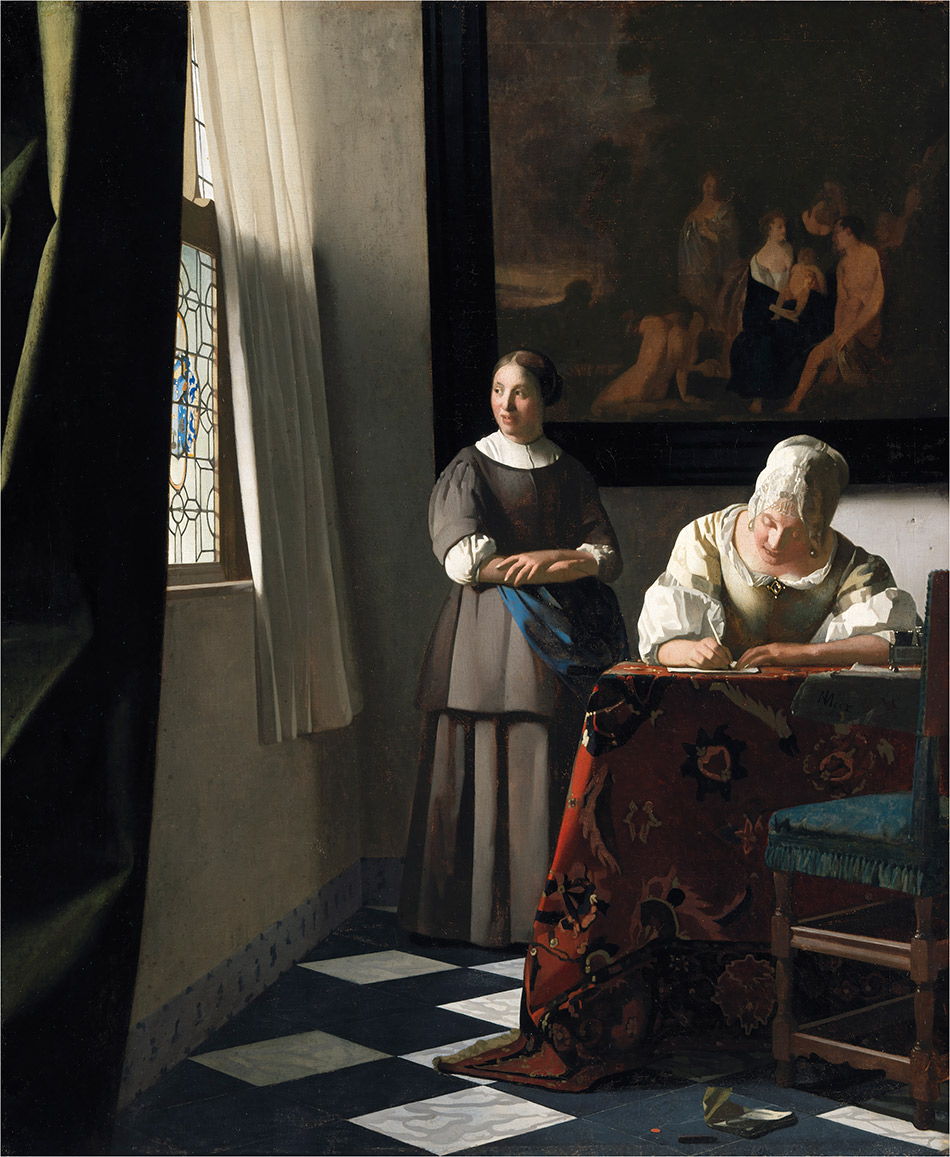 Johannes Vermeer, Woman Writing a Letter, with her Maid, c. 1670-71, oil on canvas, unframed: 72.2 × 59.7 cm (28 7/16 × 23 1/2 in.) National Gallery of Ireland, Dublin, Sir Alfred and Lady Beit, 1987 (Beit Collection) Photo © National Gallery of Ireland
Johannes Vermeer, Woman Writing a Letter, with her Maid, c. 1670-71, oil on canvas, unframed: 72.2 × 59.7 cm (28 7/16 × 23 1/2 in.) National Gallery of Ireland, Dublin, Sir Alfred and Lady Beit, 1987 (Beit Collection) Photo © National Gallery of Ireland
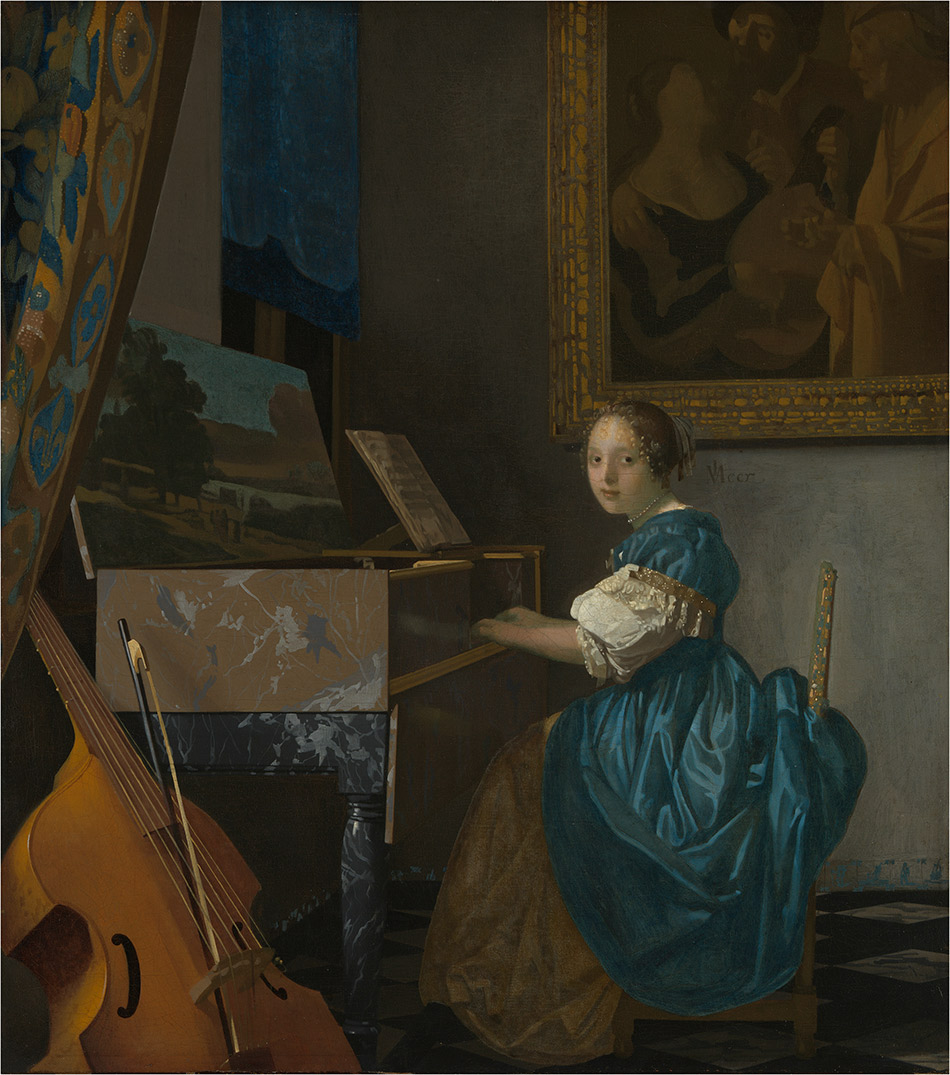 Johannes Vermeer, Young Woman Seated at a Virginal, c. 1675, oil on canvas, overall: 51.5 × 45.5 cm (20 1/4 × 17 15/16 in.) framed: 73 × 67.5 × 8.5 cm (28 3/4 × 26 9/16 × 3 3/8 in.) The National Gallery, London. Salting Bequest, 1910 © The National Gallery, London
Johannes Vermeer, Young Woman Seated at a Virginal, c. 1675, oil on canvas, overall: 51.5 × 45.5 cm (20 1/4 × 17 15/16 in.) framed: 73 × 67.5 × 8.5 cm (28 3/4 × 26 9/16 × 3 3/8 in.) The National Gallery, London. Salting Bequest, 1910 © The National Gallery, London
GERARD TER BORCH
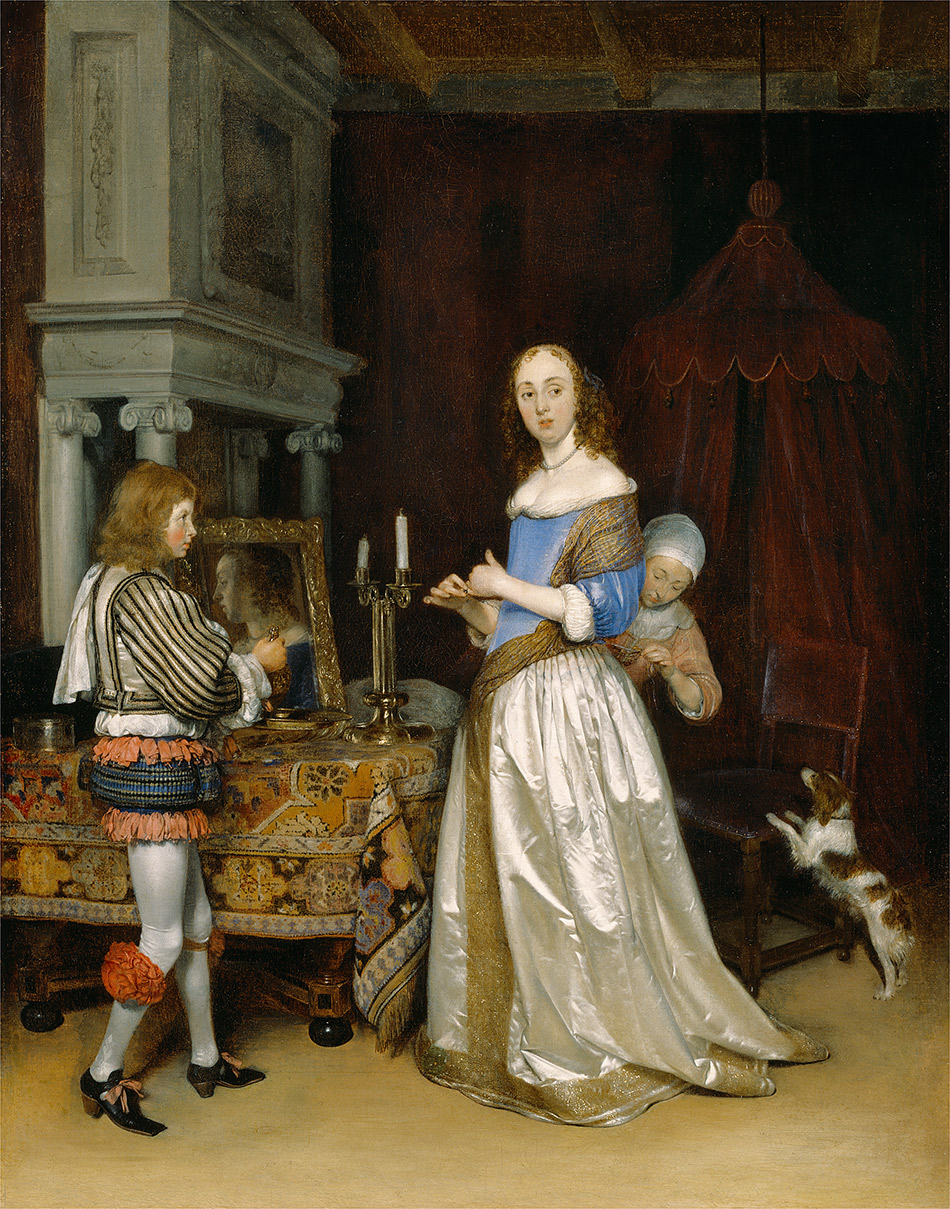 Gerard ter Borch, Lady at Her Toilet, c. 1660, oil on canvas, overall: 76.2 x 59.7 cm (30 x 23 1/2 in.) framed: 111.3 × 95.6 × 8.3 cm (43 13/16 × 37 5/8 × 3 1/4 in.) The Detroit Institute of Arts, Founders Society Purchase, Eleanor Clay Ford Fund, General Membership Fund, Endowment Income Fund and Special Activities Fund
Gerard ter Borch, Lady at Her Toilet, c. 1660, oil on canvas, overall: 76.2 x 59.7 cm (30 x 23 1/2 in.) framed: 111.3 × 95.6 × 8.3 cm (43 13/16 × 37 5/8 × 3 1/4 in.) The Detroit Institute of Arts, Founders Society Purchase, Eleanor Clay Ford Fund, General Membership Fund, Endowment Income Fund and Special Activities Fund
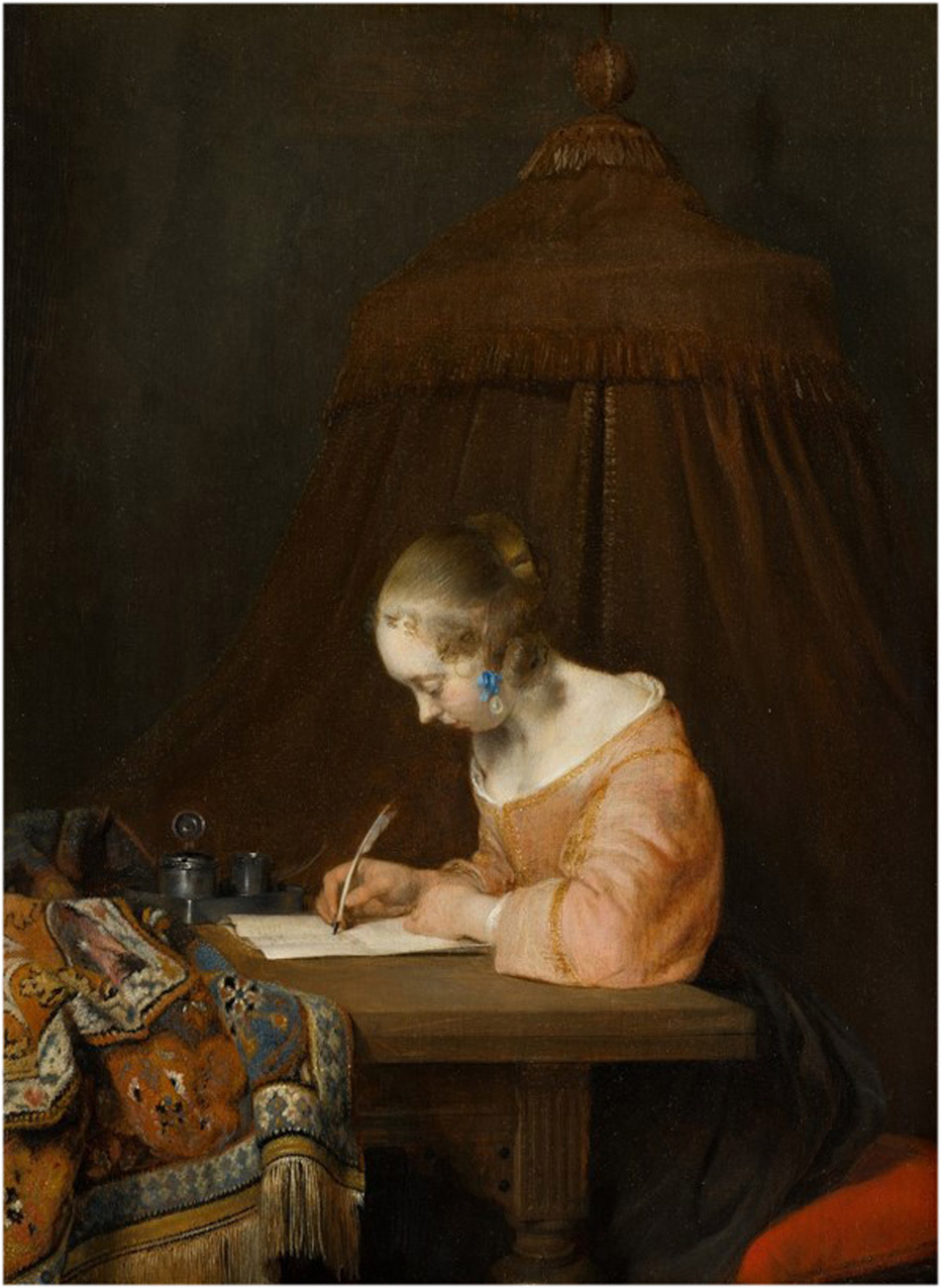 Gerard ter Borch, Woman Writing a Letter, c. 1655-56, oil on panel, overall: 39 x 29.5 cm (15 3/8 x 11 5/8 in.) Royal Picture Gallery Mauritshuis, The Hague. Gift of Sir Henri W.A. Deterding, 1928.
Gerard ter Borch, Woman Writing a Letter, c. 1655-56, oil on panel, overall: 39 x 29.5 cm (15 3/8 x 11 5/8 in.) Royal Picture Gallery Mauritshuis, The Hague. Gift of Sir Henri W.A. Deterding, 1928.
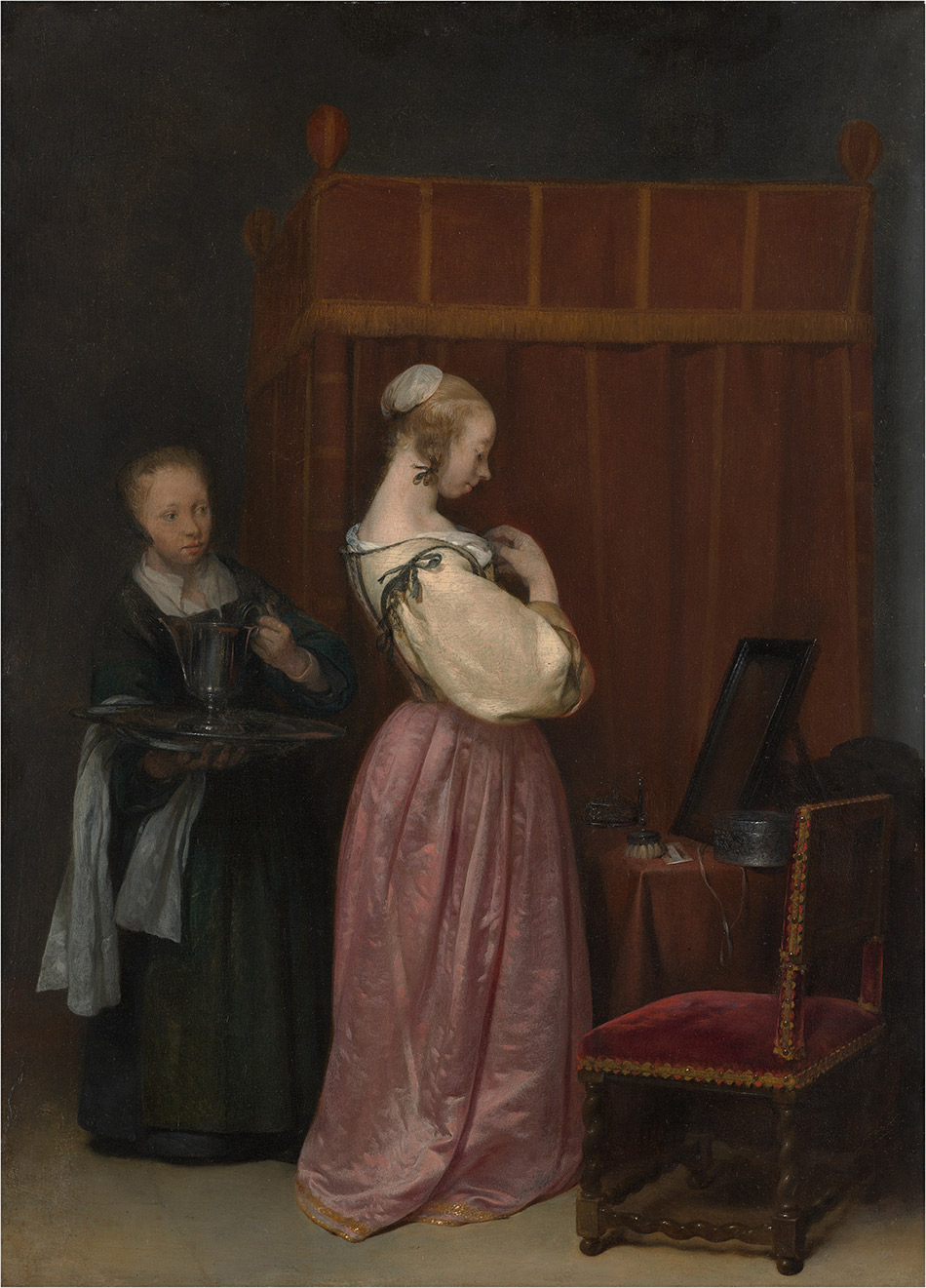 Gerard ter Borch, Young Woman at her Toilet with a Maid, c. 1650-51, oil on wood, Overall: 47.6 x 34.6 cm (18 3/4 x 13 5/8 in.) Lent by The Metropolitan Museum of Art, Gift of J. Pierpont Morgan, 1917 (17.190.10)
Gerard ter Borch, Young Woman at her Toilet with a Maid, c. 1650-51, oil on wood, Overall: 47.6 x 34.6 cm (18 3/4 x 13 5/8 in.) Lent by The Metropolitan Museum of Art, Gift of J. Pierpont Morgan, 1917 (17.190.10)
GERRIT DOU
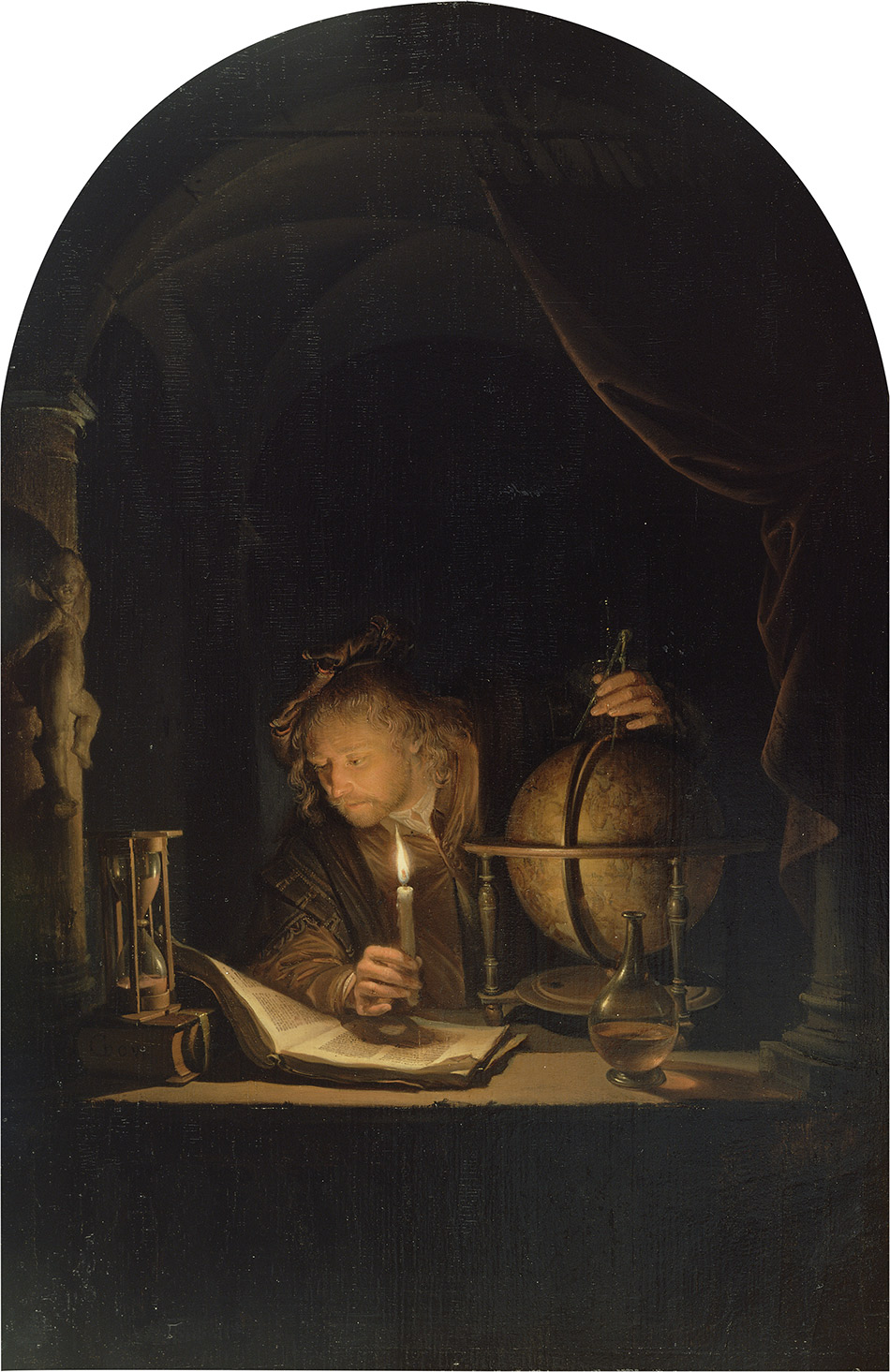 Gerrit Dou, Astronomer by Candlelight, c. 1665, oil on panel, Overall (Panel with rounded top): 32 x 21.2 cm (12 5/8 x 8 3/8 in.) framed: 52.1 x 40 cm (20 1/2 x 15 3/4 in.) The J. Paul Getty Museum, Los Angeles
Gerrit Dou, Astronomer by Candlelight, c. 1665, oil on panel, Overall (Panel with rounded top): 32 x 21.2 cm (12 5/8 x 8 3/8 in.) framed: 52.1 x 40 cm (20 1/2 x 15 3/4 in.) The J. Paul Getty Museum, Los Angeles
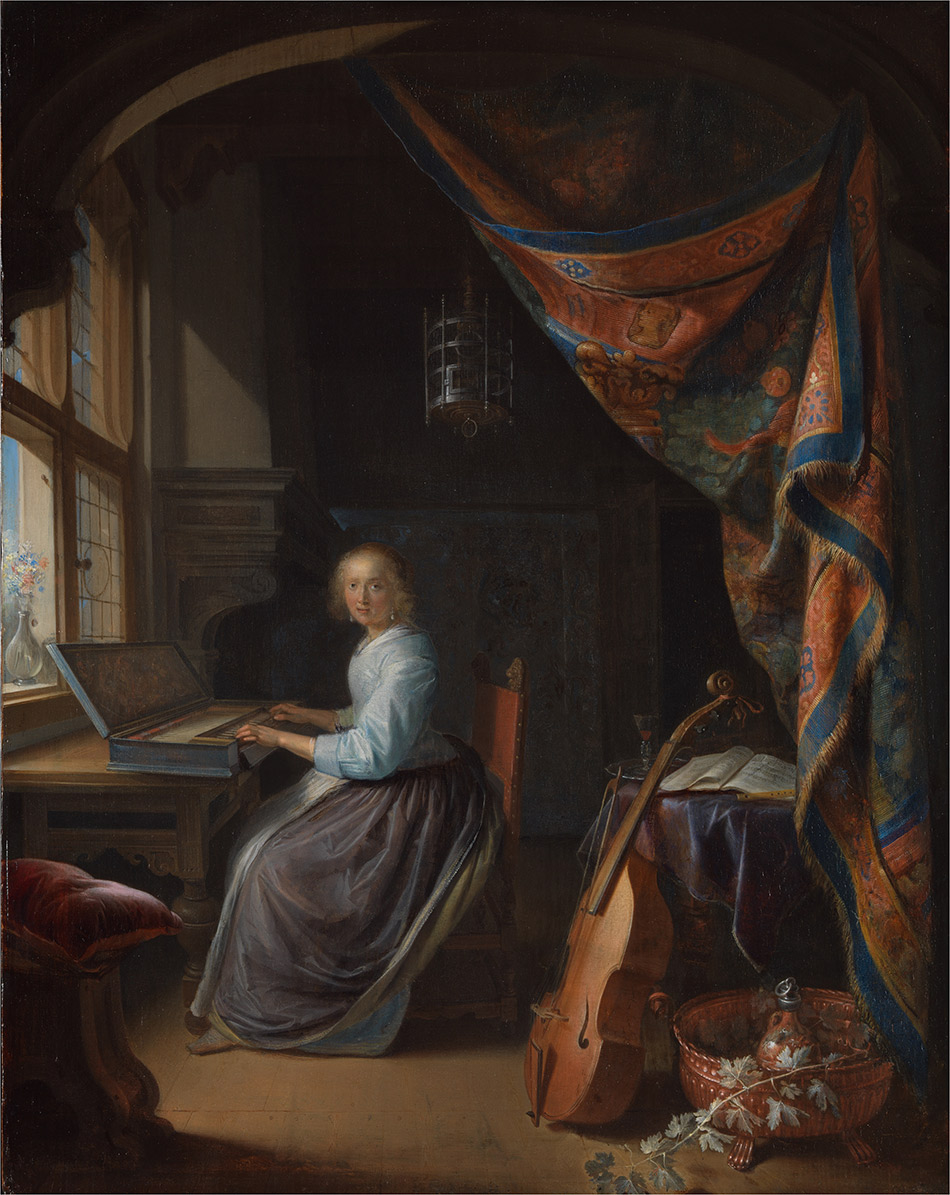 Gerrit Dou, Woman at the Clavichord, c. 1665, oil on panel, Overall: 37.7 x 29.8 cm (14 13/16 x 11 3/4 in.) framed: 52 x 44.5 x 4 cm (20 1/2 x 17 1/2 x 1 9/16 in.) By Permission of the Trustees of Dulwich Picture Gallery, London
Gerrit Dou, Woman at the Clavichord, c. 1665, oil on panel, Overall: 37.7 x 29.8 cm (14 13/16 x 11 3/4 in.) framed: 52 x 44.5 x 4 cm (20 1/2 x 17 1/2 x 1 9/16 in.) By Permission of the Trustees of Dulwich Picture Gallery, London
GABRIEL METSU
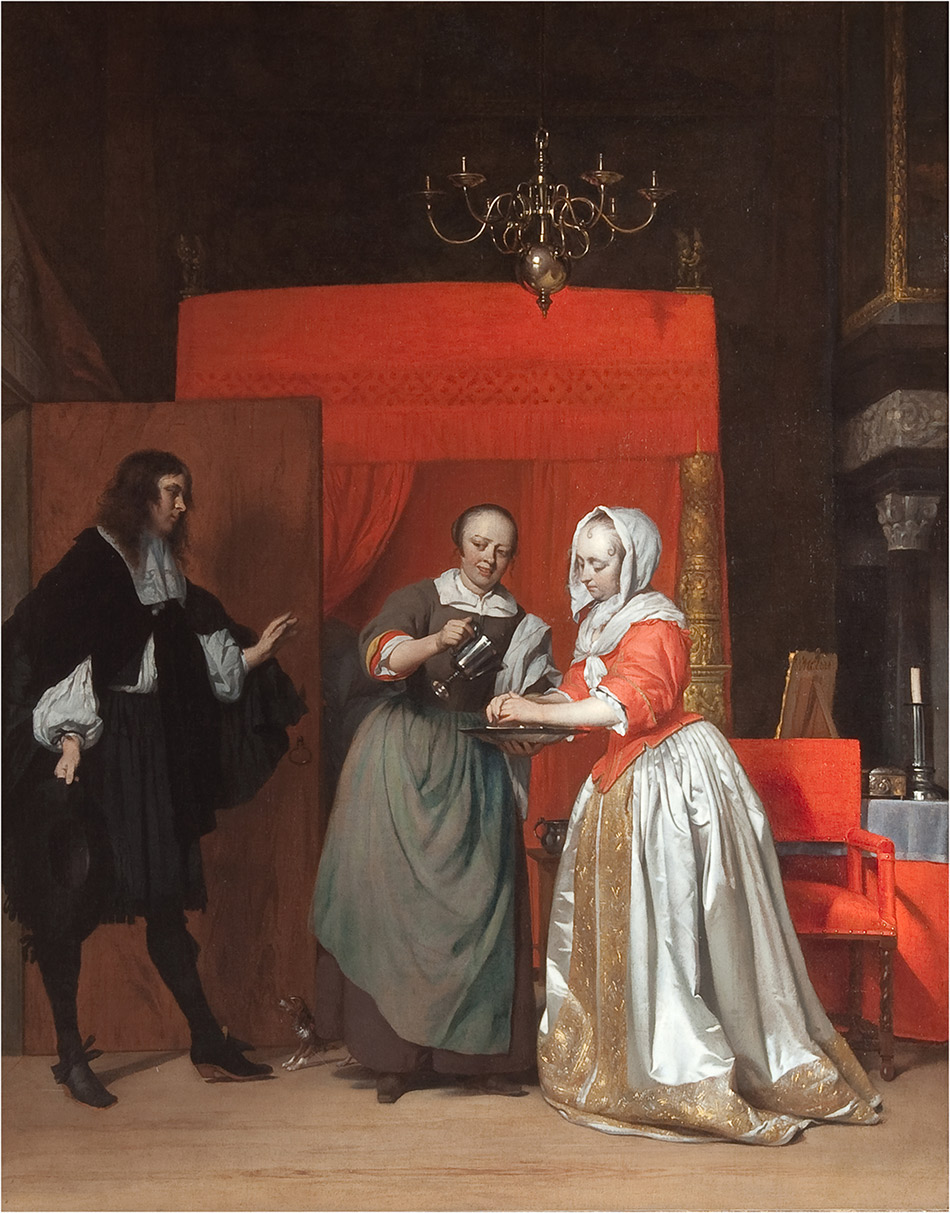 Gerrit Dou, Woman at the Clavichord, c. 1665, oil on panel, Overall: 37.7 x 29.8 cm (14 13/16 x 11 3/4 in.) framed: 52 x 44.5 x 4 cm (20 1/2 x 17 1/2 x 1 9/16 in.) By Permission of the Trustees of Dulwich Picture Gallery, London
Gerrit Dou, Woman at the Clavichord, c. 1665, oil on panel, Overall: 37.7 x 29.8 cm (14 13/16 x 11 3/4 in.) framed: 52 x 44.5 x 4 cm (20 1/2 x 17 1/2 x 1 9/16 in.) By Permission of the Trustees of Dulwich Picture Gallery, London
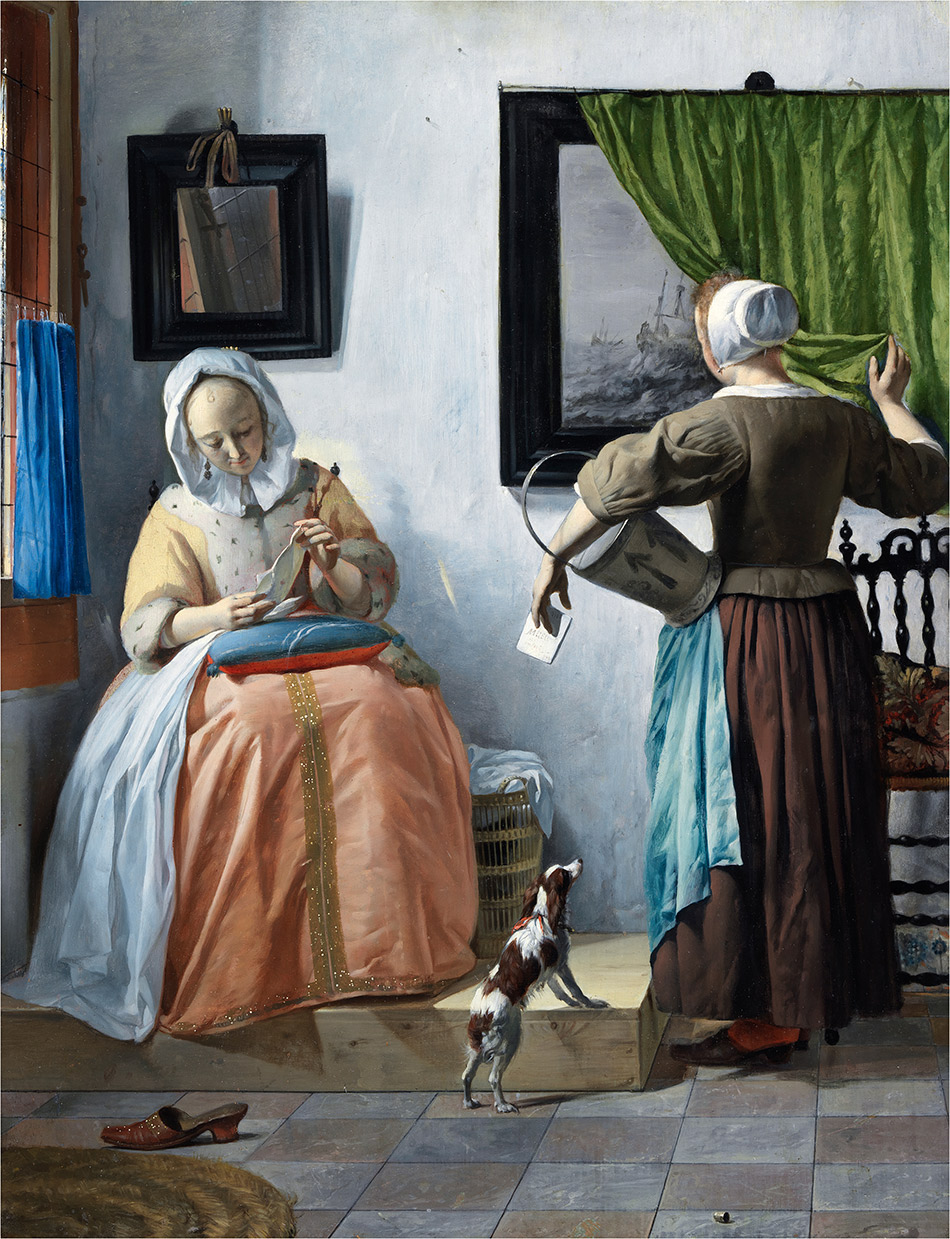 Gabriel Metsu, Woman Reading a Letter, c. 1664-66, oil on panel, unframed: 52.5 x 40.2 cm (20 11/16 x 15 13/16 in.) framed: 71.1 × 59.5 × 5.5 cm (28 × 23 7/16 × 2 3/16 in.) National Gallery of Ireland, Dublin, Sir Alfred and Lady Beit, 1987 (Beit Collection)
Gabriel Metsu, Woman Reading a Letter, c. 1664-66, oil on panel, unframed: 52.5 x 40.2 cm (20 11/16 x 15 13/16 in.) framed: 71.1 × 59.5 × 5.5 cm (28 × 23 7/16 × 2 3/16 in.) National Gallery of Ireland, Dublin, Sir Alfred and Lady Beit, 1987 (Beit Collection)
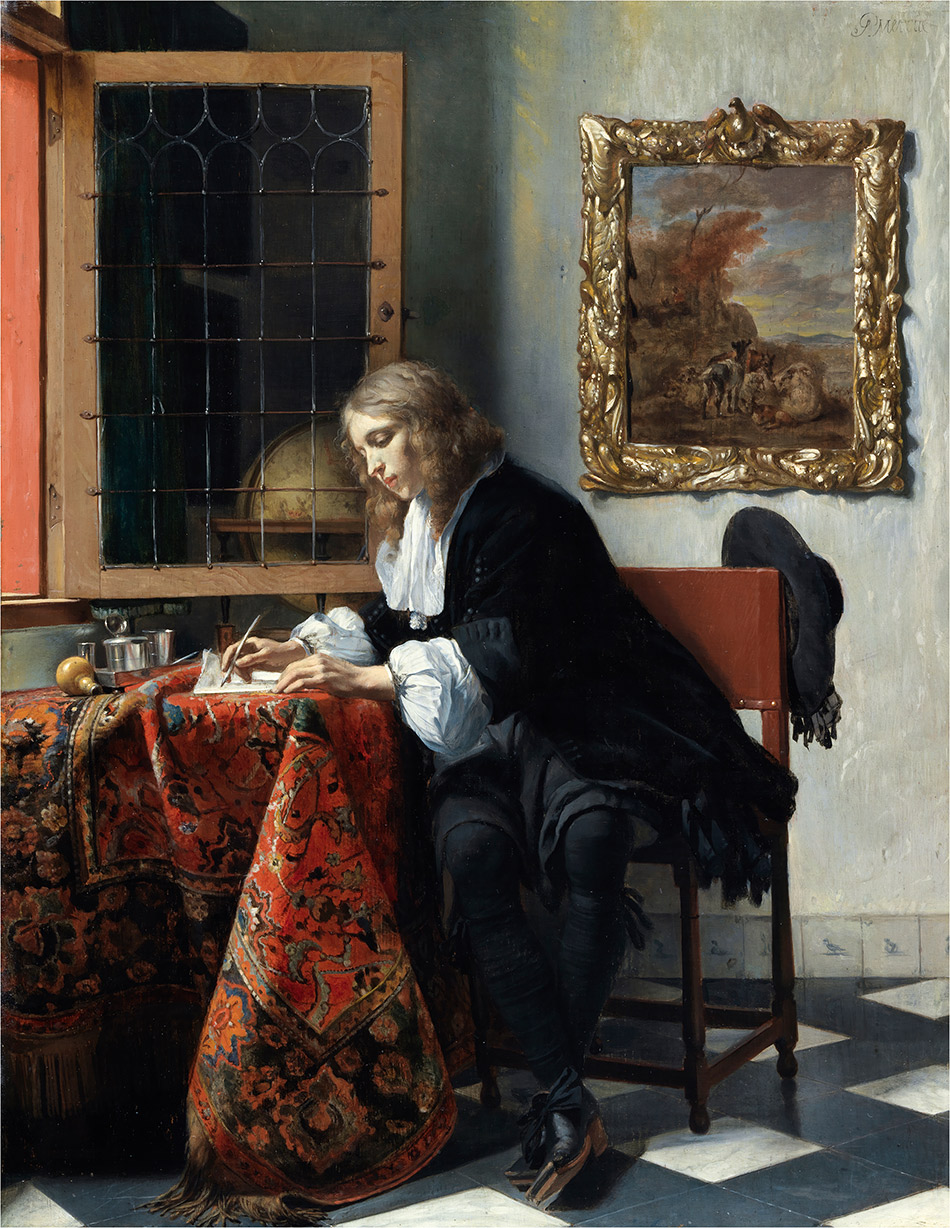 Gabriel Metsu, Man Writing a Letter, c. 1664-66, oil on panel, unframed: 52 x 40.5 cm (20 1/2 x 15 15/16 in.) framed: 71.2 × 59.2 × 5.5 cm (28 1/16 × 23 5/16 × 2 3/16 in.) National Gallery of Ireland, Dublin, Sir Alfred and Lady Beit, 1987 (Beit Collection)
Gabriel Metsu, Man Writing a Letter, c. 1664-66, oil on panel, unframed: 52 x 40.5 cm (20 1/2 x 15 15/16 in.) framed: 71.2 × 59.2 × 5.5 cm (28 1/16 × 23 5/16 × 2 3/16 in.) National Gallery of Ireland, Dublin, Sir Alfred and Lady Beit, 1987 (Beit Collection)
CASPAR NETSCHER
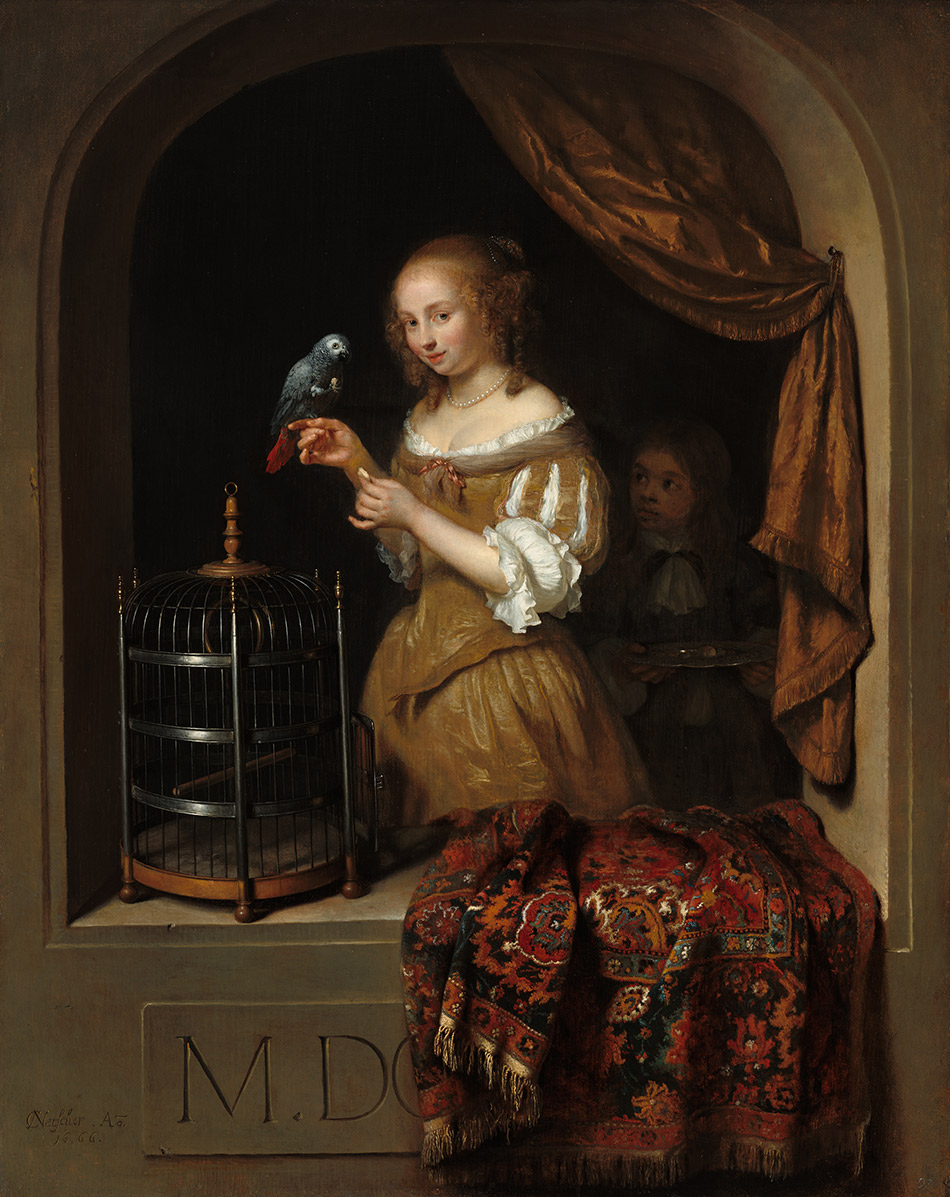 Caspar Netscher, Woman Feeding a Parrot, with a Page, 1666, oil on panel, unframed: 46 × 37 cm (18 1/8 × 14 9/16 in.) National Gallery of Art, Washington, The Lee and Juliet Folger Fund
Caspar Netscher, Woman Feeding a Parrot, with a Page, 1666, oil on panel, unframed: 46 × 37 cm (18 1/8 × 14 9/16 in.) National Gallery of Art, Washington, The Lee and Juliet Folger Fund
EGLON VAN DER NEER

Eglon van der Neer, Woman Washing her Hands, 1675, oil on panel, unframed: 49 × 39.5 cm (19 5/16 × 15 9/16 in.) Royal Picture Gallery Mauritshuis, The Hague, transferred by the Dutch State in 1960
FRANS VAN MIERIS
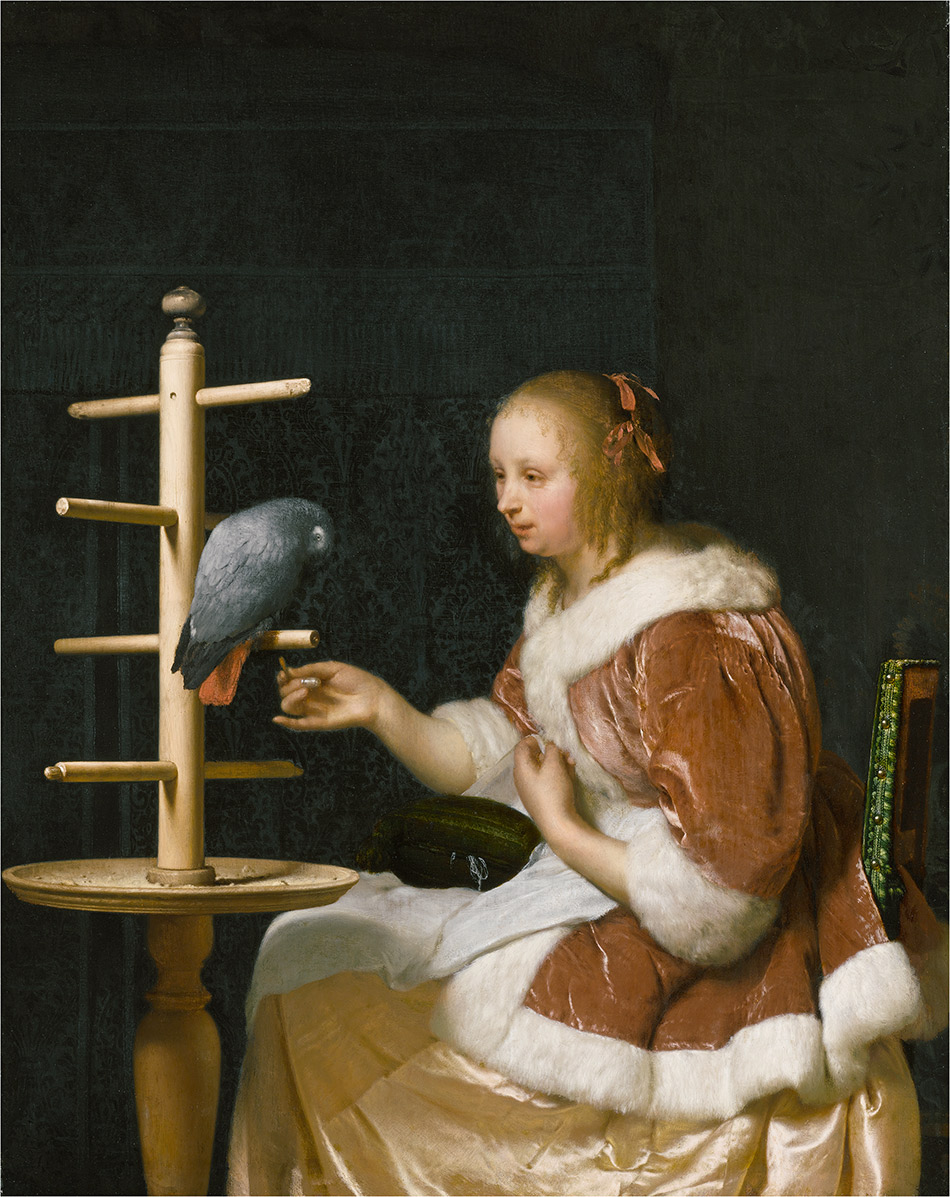
Frans van Mieris, Woman Feeding a Parrot, 1663, oil on panel, unframed: 22.38 × 17.78 cm (8 13/16 × 7 in.) framed: 40.01 × 35.2 × 5 cm (15 3/4 × 13 7/8 × 2 in.) The Leiden Collection, New York.
JAN STEEN
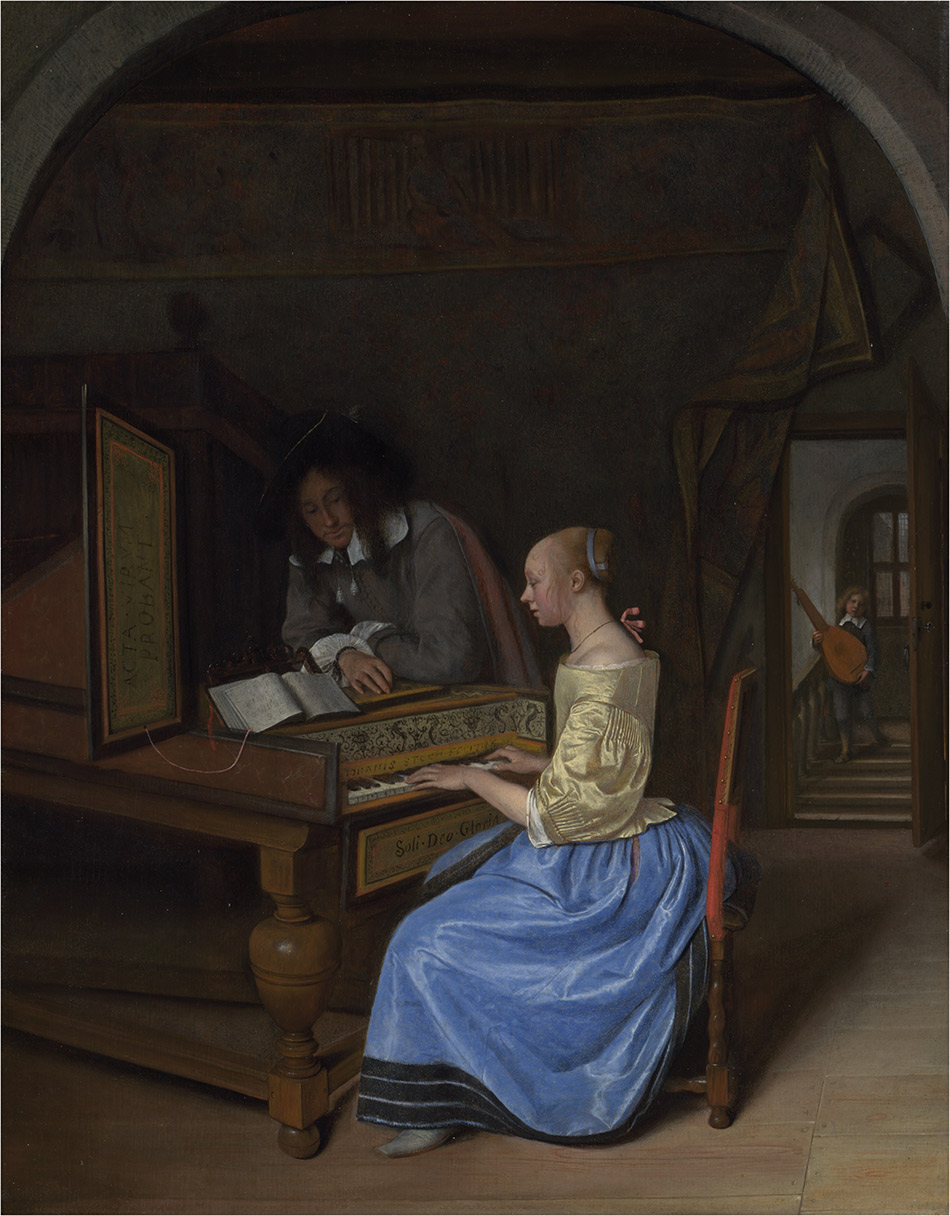
Jan Steen, Young Woman Playing a Harpsichord to a Young Man, c. 1659, oil on panel, unframed: 42.3 × 33 cm (16 5/8 × 13 in.) framed: 60.5 × 51.5 cm (23 13/16 × 20 1/4 in.) The National Gallery, London. Bought, 1871.
PIETER DE HOOCH
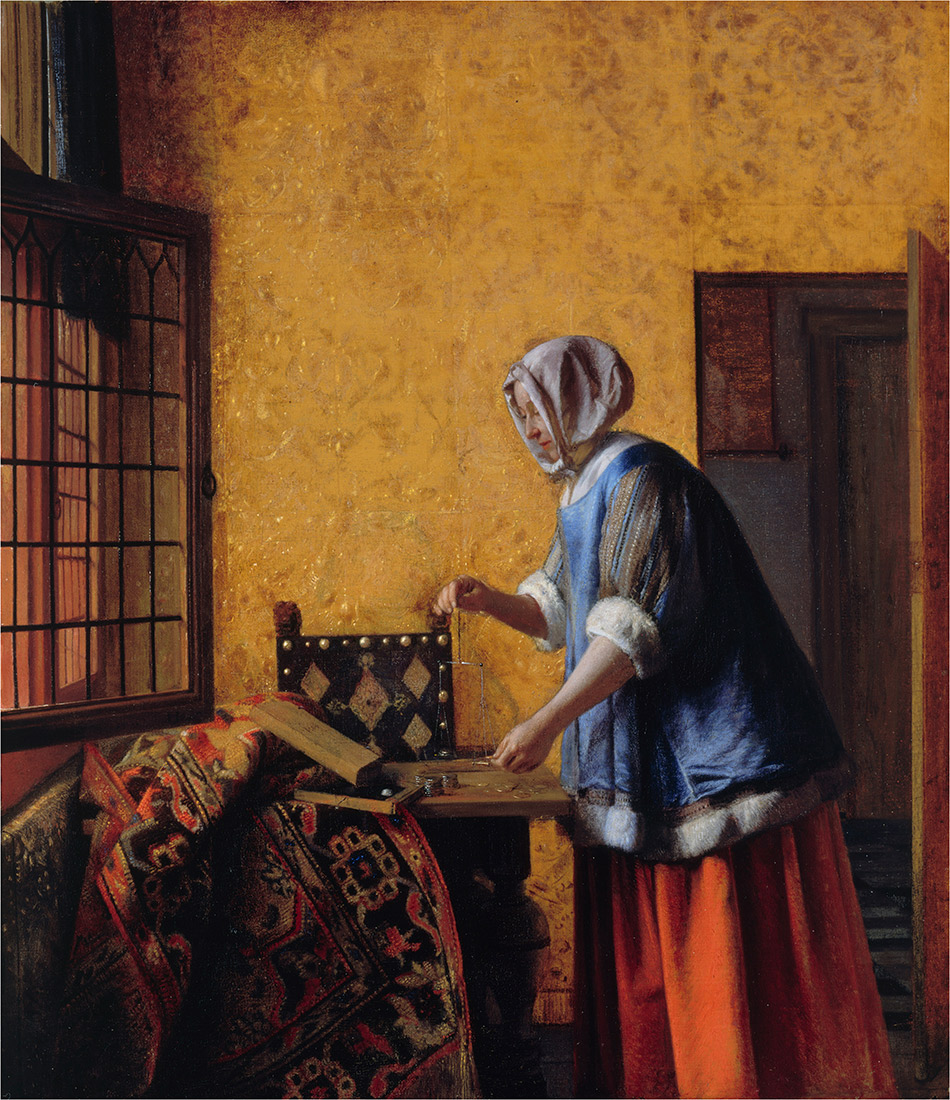 Pieter de Hooch, The Greeting, c. 1675, oil on canvas, framed: 43 3/4 x 37 5/8 x 3 3/4 in. (111.13 x 95.57 x 9.53 cm) unframed: 34 x 27 1/2 in. (86.36 x 69.85 cm) National Gallery of Art, Washington, Corcoran Collection (William A. Clark Collection)
Pieter de Hooch, The Greeting, c. 1675, oil on canvas, framed: 43 3/4 x 37 5/8 x 3 3/4 in. (111.13 x 95.57 x 9.53 cm) unframed: 34 x 27 1/2 in. (86.36 x 69.85 cm) National Gallery of Art, Washington, Corcoran Collection (William A. Clark Collection)
Vermeer and the Masters of Genre Paintingmakes clear
that artists often studied and emulated paintings by other masters.
Dutch genre painting reached the pinnacle of its popularity and technique during the third quarter of the 17th century as a network of artists working in different cities found success depicting scenes of the daily life of the elite. While little is known about exactly when artists saw paintings by those working in different cities, travel across The Netherlands was relatively easy at the time with the country’s efficient infrastructure of roads and canals. Artists would have been able to make short journeys to visit painters’ studios as well as the homes of collectors and art dealers. There are also specific instances of contact between artists such as cosigned documents, as with Vermeer and Ter Borch; a few known teacher-student relationships, including Dou and Van Mieris; and anecdotes—for example, that Steen and Van Mieris were reputedly drinking buddies.
The paintings in the exhibition are presented in groups that illustrate how artists inspired each other in their subject matter, figural motifs, stylistic decisions, and painting techniques. Subjects include women writing letters, musical duets, astronomers, lace makers, and a woman holding a parrot. One group compares three paintings of women with lutes by Van Mieris, Van Der Neer, and Vermeer while another demonstrates how a number of artists adapted an important pictorial motif in their work—a female figure standing with her back to the viewer. The motif was introduced by Ter Borch in his renowned Gallant Conversation (“The Paternal Admonition”) (c. 1654, Rijksmuseum) and then utilized in a variety of ways by De Hooch, Steen, and Ochtervelt.
The direction of influence did not strictly flow from masters to their followers. In many ways, Ter Borch and Dou were the forefathers of high-life genre painting in The Netherlands. They were incredibly influential to the younger generation of artists, many of whom were their pupils. However, the two painters also studied and emulated the work of their admirers. For instance, Dou, in his painting The Dropsical Woman (1663, Musée du Louvre), looked carefully at Van Mieris’s earlier depiction of that same theme, but enlarged his interior setting and increased the number of figures to create a more ambitious work than his former pupil produced.
Vermeer, no less than his contemporaries, looked carefully at paintings by different artists, and most of the groups in this exhibition include at least one work by the Delft master. A particularly interesting connection exists between Vermeer’s Woman with a Pearl Necklace (c. 1662–1665, Gemäldegalerie) and Van Mieris’s Woman before a Mirror (c. 1662, Gemäldegalerie). The similar subjects of these paintings, in which a woman is shown standing in profile before a table and adjusting her necklace, was not their invention but that of Ter Borch in his Young Woman at her Toilet with a Maid (c. 1650–1651, The Metropolitan Museum of Art). Through such juxtapositions, one is able to understand the distinctive qualities that each of these artists brought to their subjects. For example, the woman in Vermeer’s Woman with a Pearl Necklace has a timelessness that evokes inner strength and purity, thus providing this genre scene with a moral and philosophical underpinning more traditionally associated with history paintings.
STATEMENT
 Earl A. Powell III,
Earl A. Powell III,
director, National Gallery of Art, Washington
“The 1995 Johannes Vermeershow endures as one of the most significant exhibitions in the Gallery’s history. Vermeer and the Masters of Genre Painting will undoubtedly have the same impact while also deeply enriching our understanding of the web of influence among 17th-century Dutch artists,”
“This exhibition would not have been possible without the incredible generosity of the lenders, both museums and private collectors, or the support of the Hata Foundation, Dr. Mihael and Mrs. Mahy Polymeropoulos, The Exhibition Circle of the National Gallery of Art, and BP p.l.c.”
Organization and Curators
The exhibition is organized by the National Gallery of Art, Washington, the National Gallery of Ireland, Dublin, and the Musée du Louvre, Paris. The exhibition is on view at the Musée du Louvre from February 20 through May 22, 2017 and at the National Gallery of Ireland from June 17 through September 17, 2017.

The exhibition is curated by Arthur K. Wheelock Jr., curator of northern baroque paintings, National Gallery of Art, Washington; Adriaan Waiboer, head of collections and research, National Gallery of Ireland, Dublin (who initiated the exhibition concept); and Blaise Ducos, curator of Dutch and Flemish paintings, Musée du Louvre, Paris.
CATALOGUE
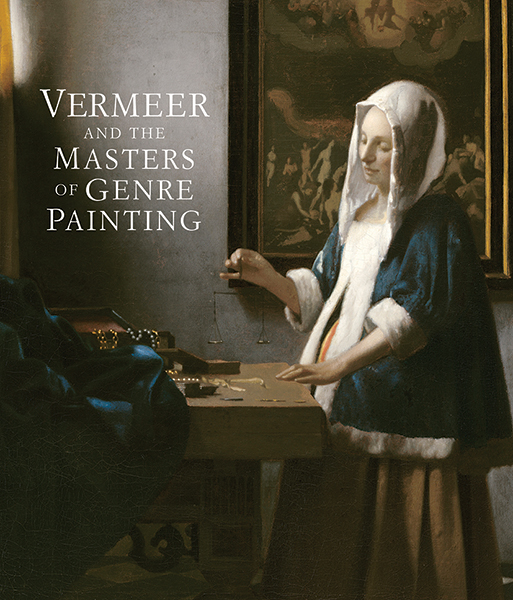
180 color illustrations
320-page
Catalog will be available in both hardcover and softcover
Published by the National Gallery of Art, Ireland, the National Gallery of Art, Washington, and the Musée du Louvre, Paris, in association with Yale University Press, a fully illustrated catalog features essays by the curators and an esteemed group of international scholars. The catalog also includes a timeline of the recorded and conjectured visits of 10 of these artists and 22 entries discussing the various thematic groupings of paintings.
NATIONAL GALLERY OF ART, Washington
6th and Constitution Avenue NW, Washington, DC 20565
Telephone: (202) 737-4215 Accessibility Information: (202) 842-6905
http://www.nga.gov/
Hours: Monday–Saturday, 10 a.m.–5 p.m. Sunday, 11 a.m.–6 p.m.